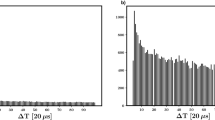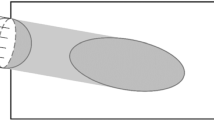Abstract
Because of low signal-to-noise ratios, the main difficultly in real-world detection scenarios is distinguishing between benign sources and potentially-threatening radioactive materials. The variability in observed signal during a radiation detection search operation can be contributed to the stochastic nature of the underlying physics and the systematic errors inherent to the detection systems employed. This variability is compounded for dynamic detection scenarios, where objects, referred to as clutter, traverse through the primary detection scene, introducing potential suppressions in the observed signal due to the attenuation of background radiation. This study examines the impact that clutter, namely automobiles such as small utility vehicles, sedans, and trucks, produces on the observed signal in a 2 in. × 4 in. × 16 in. NaI(Tl) detector. The clutter is identified and tracked in the detection scene using a time-synced video camera and a 2-D light distance and ranging contextual sensors. Two experiments were performed on the Oak Ridge National Laboratory reservation: one using a distributed source within the scene to understand the systematics of detecting and analyzing the clutter, and the second experiment mimicking an urban environment with large buildings positioned on either side of a roadway. The experiments exhibited unique results in the amount of signal suppression and variability of the cluttered signal, both demonstrating an observable suppression from the clutter-free background. These results reveal a new potential category of signal noise intrinsic to real-world detection scenarios that should be considered when establishing detection thresholds based on expected values.















Similar content being viewed by others
References
Lei E (2017) Robust detection of radiation threat. In: IEEE nuclear science symposium and medical imaging conference
Anderson KK, Jarman KD, Mann ML, Pfund DM, Runkle RC (2008) Discriminating nuclear threats from benign sources in gamma-ray spectra using a spectral comparison ratio method. J Radioanal Nucl Chem 276(3):713–718
Runkle RC, Tardiff MF, Anderson KK, Carlson DK, Smith LE (2006) Analysis of spectroscopic radiation portal monitor data using principal components analysis. IEEE Trans Nucl Sci 53(3):1418–1423
Chandy KM, Bunn JJ, Liu AH (2010) Models and algorithms for radiation detection. Department of Computer Science, California Institute of Technology, Pasadena
Ghelman M et al (2009) Improving the detecting performances of radiation portal monitors using matched filter algorithm and generalized likelihood ratio test. In: IEEE nuclear science symposium conference record, pp 918–919
Du Q, Wei W, May D, Younan NH (2010) Noise-adjusted principal component analysis for buried radioactive target detection and classification. IEEE Trans Nucl Sci 57(6):3760–3767
Archer DE, Johnson JO, Miller TM, Nicholson AD, Patton BW, Peplow DE (2015) Systematic assessment of neutron and gamma backgrounds relevant to operational modeling and detection technology implementation. Report no. ORNL/TM-2014/687, Oak Ridge National Laboratory, Oak Ridge, TN
Pfund DM, Jarman KD, Milbrath BD, Kiff SD, Sidor DE (2010) Low count anomaly detection at large standoff distances. IEEE Trans Nucl Sci 57(1):309–316
Runkle RC, Smith LE, Peurrung AJ (2009) The photon haystack and emerging radiation detection technology. J Appl Phys 106(4):7
Sandness GA, Schweppe JE, Hensley WK, Borgardt JD, Mitchell AL (2009) Accurate modeling of the terrestrial gamma-ray background for homeland security applications. In: IEEE nuclear science symposium conference record, pp 126–133
Hutcheson AL, Phlips BF, Wulf EA, Mitchell LJ, Johnson WN, Leas BE (2013) Maritime detection of radiological/nuclear threats with hybrid imaging system. In: IEEE international conference on technologies for homeland security, pp. 360–363
Minty BRS (1997) Fundamentals of airborne gamma-ray spectrometry. J Aust Geol Geophys 17(2):39–50
Dickson BL, Scott KM (1997) Interpretation of aerial gamma-ray surveys—adding the geochemical factors. AGSO J Aust Geol Geophys 17(2):187–200
US Environmental Protection Agency (2000) Evaluation of EPA’s guidelines for technologically enhanced naturally occurring radioactive materials: report to congress. Report No. EPA 402-R-00-01
Haquin G (2008) Natural radioactivity and radon in building materials. In: 12th congress international radiation protection association. Buenos Aires, Argentina, pp 1–13
Aucott TJ, Bandstra MS, Negut V, Chivers DH, Cooper RJ, Vetter K (2013) Routine surveys for gamma-ray background characterization. IEEE Trans Nucl Sci 60(2):1147–1150
Aguayo E, Kouzes R, Orrell J, Ankney A, Troy M, Berguson T Cosmic ray interactions in shielding materials. Report No. PNNL-20693, Pacific Northwest National Laboratory, Richland, WA 99352
Grieder PKF (2001) Cosmic rays at earth. Elsevier, New York
National Urban Security Technology Laboratory (2015) Portable radiation portal monitors market survey report. Report No. MSR-0315-508, Department of Homeland Security
Bandstra MS et al (2016) RadMAP: the radiological multi-sensor analysis platform. Nucl Instrum Methods Phys Res Sect A Accel Spectrom Detect Assoc Equip 840:59–68
Aucott T (2014) Gamma-ray background variability in mobile detectors. University of California, Berkeley
Quiter BJ, Ramakrishnan L, Bandstra MS (2015) GRDC: a collaborative framework for radiological background and contextual data analysis. Report No. LBNL-1003947, Lawrence Berkeley National Laboratory
Mitchell LJ et al (2009) Mobile imaging and spectroscopic threat identification (MISTI): system overview. In: IEEE nuclear science symposium conference
Ubiquiti Networks Ubiquiti networks. https://www.ubnt.com/. Accessed 8 Jan 2018.
Scanse LLC. Sweep 2-D LiDAR. http://scanse.io/. Accessed 8 Jan 2018.
Blase RC, Llera K, Luspay-Kuti A, Libardoni M (2014) The importance of detector acquisition rate in comprehensive two-dimensional gas chromatography (GC × GC). Sep Sci Technol 49(6):847–853
Zuberi S (2003) Digital signal processing of scintillator pulses in nuclear physics techniques. Senior thesis, University of Rochester
Currie AL (1968) Limits for qualitative detection and quantitative determination. Anal Chem 40:586–593
Acknowledgements
This work was sponsored by the Enabling Capabilities for Nonproliferation and Arms Control Program Area of the Office of Defense Nuclear Nonproliferation Research and Development, National Nuclear Security Administration.
Author information
Authors and Affiliations
Corresponding author
Rights and permissions
About this article
Cite this article
Stewart, I.R., Nicholson, A.D., Archer, D.E. et al. Understanding and quantifying the systematic effects of clutter within a radiation detection scene. J Radioanal Nucl Chem 318, 727–737 (2018). https://doi.org/10.1007/s10967-018-6159-8
Received:
Published:
Issue Date:
DOI: https://doi.org/10.1007/s10967-018-6159-8




